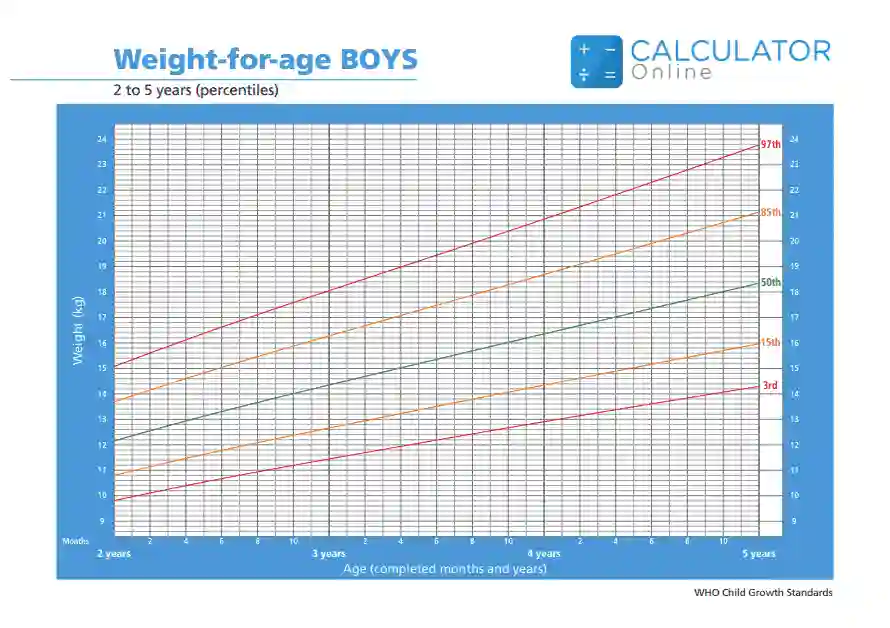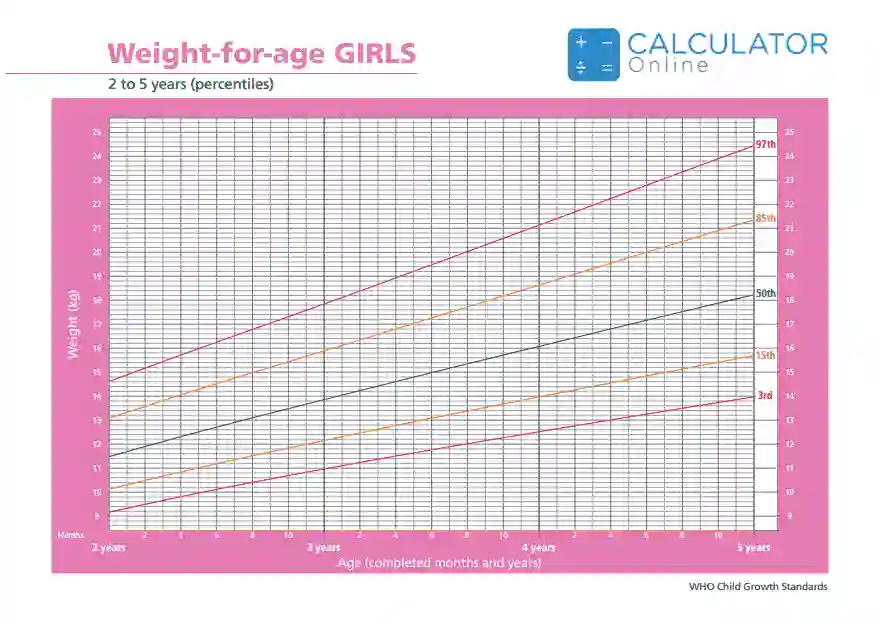Adblocker Detected

We always struggled to serve you with the best online calculations, thus, there's a humble request to either disable the AD blocker or go with premium plans to use the AD-Free version for calculators.
Disable your Adblocker and refresh your web page 😊
Table of Content
This baby weight percentile calculator is specifically designed and set up for you to calculate your child’s weight velocity (weight growth over time).
So if you are wondering about what percentile is my baby, you are actually in need to go through the article below.
Let’s read!
According to schematics as introduced by World Health Organization (WHO):
“If your child is lying at the 50th percentile line on the weight percentile graph, then it depicts that you are comparing your child with 100 other children of his/her age. And there will be 50 children heavier than your child and the remaining 50 will be lighter in weight. Likewise, 75th line cut would represent that your child is more in weight than 75 children from 100 of his/her age and lighter in weight than 25 remaining”
If you are in search of some good resource like growth charts as provided by WHO, then look no further as our free baby growth chart calculator would ultimately assist you in this regard.
As everyone of us is well known of the fact that babies show a sudden rise in weight in certain age spans. That is why it becomes somehow difficult to observe and say what would be the weight growth of your child at a certain age. But do not worry as this free baby weight percentile calculator is all that will allow you to estimate the average rise in growth.
Also, WHO has arranged the data in child’s growth charts that is the basis of this child growth chart calculator’s working as well. This is why our free calculator will help you to calculate results as per the standards set by WHO.
Usually, doctors follow certain guidelines to clarify the child’s weight growth. These include:
Moreover, our smart height and weight percentile calculator also lets you know in which percentile your baby’s weight is lying with reference to his/her peers.
Growth charts are the graphical representation of the percentile curves that are used to define certain body measurements (weight, height, or head circumference) of US children. Apart from the weight percentile chart, you can also get a full detailed height percentile chart by using our another height percentile calculator.
Since the year 1977, paediatricians, nurses, and doctors have been using the growth charts to analyse the growth (normal or abnormal) of the children in the United States. The National Center for Health Statistics (NCHS) introduced these charts as reference study charts and later on in the same year, the World Health Organization adopted them for International use as well. And our free cdc growth chart calculator also helps you to swiftly look for your child’s weight percentiles.
Below here we have a couple of tables that highlights the weight percentage charts for children ranging from o weeks to 13 weeks.
For Girls:
|
Weeks |
3rd | 15th | Median | 85th | 97th |
| 0 | 2.5 | 2.9 | 3.3 | 3.9 |
4.3 |
|
1 |
2.6 | 3.0 | 3.5 | 4.0 | 4.5 |
| 2 | 2.8 | 3.2 | 3.8 |
4.3 |
4.9 |
|
3 |
3.1 | 3.5 | 4.1 | 4.7 | 5.2 |
| 4 | 3.4 | 3.8 | 4.4 | 5.0 |
5.6 |
|
5 |
3.6 | 4.1 | 4.7 | 5.3 | 5.9 |
| 6 | 3.8 | 4.3 | 4.9 | 5.6 |
6.3 |
|
7 |
4.1 | 4.5 | 5.2 | 5.9 | 6.5 |
| 8 | 4.3 | 4.7 | 5.4 | 6.2 |
6.8 |
|
9 |
4.4 | 4.9 | 5.6 | 6.4 | 7.1 |
| 10 | 4.6 | 5.1 | 5.8 | 6.6 |
7.3 |
|
11 |
4.8 | 5.3 | 6.0 | 6.8 | 7.5 |
| 12 | 4.9 | 5.5 | 6.2 | 7.0 |
7.7 |
|
13 |
5.1 | 5.6 | 6.4 | 7.2 | 7.9 |
|
Weeks |
3rd | 15th | Median | 85th | 97th |
|
0 |
2.5 | 2.9 | 3.3 | 3.9 | 4.3 |
| 1 | 2.6 | 3.0 | 3.5 | 4.0 |
4.5 |
|
2 |
2.8 | 3.2 | 3.8 | 4.3 | 4.9 |
| 3 | 3.1 | 3.5 | 4.1 | 4.7 |
5.2 |
|
4 |
3.4 | 3.8 | 4.4 | 5.0 | 5.6 |
| 5 | 3.6 | 4.1 | 4.7 | 5.3 |
5.9 |
|
6 |
3.8 | 4.3 | 4.9 | 5.6 | 3.6 |
| 7 | 4.1 | 4.5 | 5.2 | 5.9 |
6.5 |
|
8 |
4.3 | 4.7 | 5.4 | 6.2 | 6.8 |
| 9 | 4.4 | 4.9 | 5.6 | 6.4 |
7.1 |
|
10 |
4.6 | 5.1 | 5.8 | 6.6 | 7.3 |
| 11 | 4.8 | 5.3 | 6.0 | 6.8 |
7.5 |
|
12 |
4.9 | 5.5 | 6.2 | 7.0 | 7.7 |
| 13 | 5.1 | 5.6 | 6.4 | 7.2 |
7.9 |
The baby weight percentile calculator also considers these values to display the accurate results in accordance with the WHO charts for children’s growth in weight. With that, you can also make use of our another percentile calculator that will help you to compare percentiles of any specific number with other numbers in a data.
The percentile graphs against your child age is given as under:


These interpretations of weight percentiles are what displayed and calculated by our free growth percentile calculator. Also, you may like to visit WHO site in order to analyse these graphs properly.
These percentiles can better be interpreted by using our free WHO growth chart calculator. So what are you looking for if the best solution is right around the corner for you.
Our free baby percentile calculator requires the following inputs to calculate the growth percentiles of your baby!
Input:
Output:
The best calculator does the following calculations:
Yes exactly!!! Your child’s growth must continue normally. In case the fluctuations increase up to or more than 2 percentiles, you are actually in need to consult a doctor.
It’s quite simple. All you need to do is to follow up a WHO chart to calculate percentile of your baby. And while doing so, keep the following points in your mind!
Moreover, you can also let this infant Baby weight percentile calculator baby perform instant calculations
When determining the child’s percentile, you are basically in need of the following three things:
A good percentile does lie in between 5th and 85th percentile. If a baby has a weight percentile above than 85 but less than 95, then its in the obese range and this is when you are in need to consult with the doctor.
Weight velocities of your children up to 5 years of age are crucial statistics that assist to analyse their normal or abnormal growth. And keeping in view the importance of this medical fact, we have designed this WHO weight percentile calculator so as to keep notice of every day changes in your baby’s weight.
From the source of Wikipedia: Growth chart, Quantitative Definitions, Common Variants of Normal Growth, Clinical Significance, Variability in Growth Charts
From the source of Khan Academy: Calculate percentiles, Analyzing a cumulative relative frequency graph, Z-score
From the source of Lumen Learning: Physical Growth and Brain Development in Infancy, Overall Physical Growth, Body Proportions, The Brain in the First Two Years